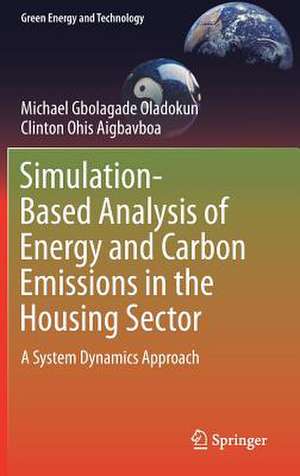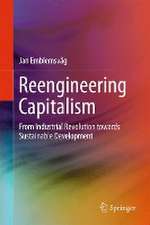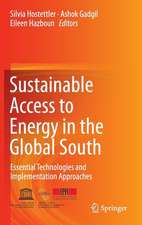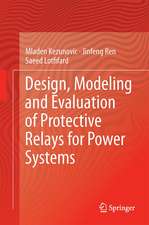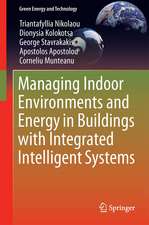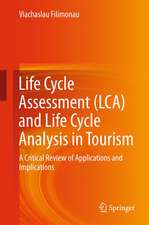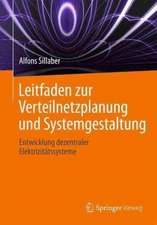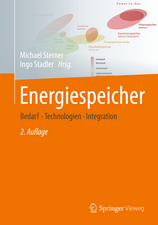Simulation-Based Analysis of Energy and Carbon Emissions in the Housing Sector: A System Dynamics Approach: Green Energy and Technology
Autor Michael Gbolagade Oladokun, Clinton Ohis Aigbavboaen Limba Engleză Hardback – 4 mai 2018
This book describes the development of a system dynamics-based model that can capture the future trajectories of housing energy and carbon emissions. It approaches energy and carbon emissions in the housing sector as a complex socio-technical problem involving the analysis of intrinsic interrelationships among dwellings, occupants and the environment.
Based on an examination of the UK housing sector but with relevance worldwide, the book demonstrates how the systems dynamics simulation can be used as a learning laboratory regarding future trends in housing energy and carbon emissions. The authors employ a pragmatic research strategy, involving the collection of both qualitative and quantitative data to develop a model. The book enriches readers’ understanding of the complexity involved in housing energy and carbon emissions from a systems-thinking perspective. As such, it will be of interest to researchers in the fields of architectural engineering, housing studies and climate change, while also appealing to industry practitioners and policymakers specializing in housing energy.
| Toate formatele și edițiile | Preț | Express |
|---|---|---|
| Paperback (1) | 641.38 lei 6-8 săpt. | |
| Springer International Publishing – 24 ian 2019 | 641.38 lei 6-8 săpt. | |
| Hardback (1) | 647.59 lei 6-8 săpt. | |
| Springer International Publishing – 4 mai 2018 | 647.59 lei 6-8 săpt. |
Din seria Green Energy and Technology
- 18%
 Preț: 943.43 lei
Preț: 943.43 lei - 20%
 Preț: 629.52 lei
Preț: 629.52 lei - 18%
 Preț: 1124.92 lei
Preț: 1124.92 lei - 18%
 Preț: 947.35 lei
Preț: 947.35 lei - 15%
 Preț: 655.92 lei
Preț: 655.92 lei - 18%
 Preț: 957.62 lei
Preț: 957.62 lei - 18%
 Preț: 789.52 lei
Preț: 789.52 lei - 17%
 Preț: 464.56 lei
Preț: 464.56 lei - 15%
 Preț: 645.79 lei
Preț: 645.79 lei - 18%
 Preț: 903.93 lei
Preț: 903.93 lei - 24%
 Preț: 1322.09 lei
Preț: 1322.09 lei - 18%
 Preț: 890.54 lei
Preț: 890.54 lei - 18%
 Preț: 1115.46 lei
Preț: 1115.46 lei - 18%
 Preț: 1117.03 lei
Preț: 1117.03 lei - 18%
 Preț: 949.73 lei
Preț: 949.73 lei - 18%
 Preț: 892.11 lei
Preț: 892.11 lei - 15%
 Preț: 648.24 lei
Preț: 648.24 lei - 18%
 Preț: 997.09 lei
Preț: 997.09 lei - 15%
 Preț: 579.81 lei
Preț: 579.81 lei - 18%
 Preț: 1123.15 lei
Preț: 1123.15 lei - 18%
 Preț: 961.41 lei
Preț: 961.41 lei - 17%
 Preț: 490.23 lei
Preț: 490.23 lei - 18%
 Preț: 904.60 lei
Preț: 904.60 lei - 15%
 Preț: 643.34 lei
Preț: 643.34 lei -
 Preț: 287.91 lei
Preț: 287.91 lei - 24%
 Preț: 634.05 lei
Preț: 634.05 lei -
 Preț: 379.40 lei
Preț: 379.40 lei - 18%
 Preț: 783.20 lei
Preț: 783.20 lei - 18%
 Preț: 1394.84 lei
Preț: 1394.84 lei - 18%
 Preț: 1691.57 lei
Preț: 1691.57 lei - 18%
 Preț: 1112.48 lei
Preț: 1112.48 lei - 15%
 Preț: 592.61 lei
Preț: 592.61 lei - 18%
 Preț: 952.09 lei
Preț: 952.09 lei - 18%
 Preț: 944.19 lei
Preț: 944.19 lei - 18%
 Preț: 891.33 lei
Preț: 891.33 lei - 18%
 Preț: 1252.44 lei
Preț: 1252.44 lei - 18%
 Preț: 789.52 lei
Preț: 789.52 lei - 20%
 Preț: 566.30 lei
Preț: 566.30 lei - 18%
 Preț: 1113.71 lei
Preț: 1113.71 lei - 18%
 Preț: 1114.24 lei
Preț: 1114.24 lei - 24%
 Preț: 590.60 lei
Preț: 590.60 lei - 20%
 Preț: 567.50 lei
Preț: 567.50 lei - 24%
 Preț: 907.50 lei
Preț: 907.50 lei - 18%
 Preț: 952.89 lei
Preț: 952.89 lei - 18%
 Preț: 952.89 lei
Preț: 952.89 lei - 18%
 Preț: 950.52 lei
Preț: 950.52 lei
Preț: 647.59 lei
Preț vechi: 761.87 lei
-15% Nou
Puncte Express: 971
Preț estimativ în valută:
123.96€ • 134.69$ • 104.19£
123.96€ • 134.69$ • 104.19£
Carte tipărită la comandă
Livrare economică 21 aprilie-05 mai
Preluare comenzi: 021 569.72.76
Specificații
ISBN-13: 9783319753454
ISBN-10: 3319753452
Pagini: 320
Ilustrații: XXV, 287 p. 134 illus., 120 illus. in color.
Dimensiuni: 155 x 235 mm
Greutate: 0.62 kg
Ediția:1st ed. 2018
Editura: Springer International Publishing
Colecția Springer
Seria Green Energy and Technology
Locul publicării:Cham, Switzerland
ISBN-10: 3319753452
Pagini: 320
Ilustrații: XXV, 287 p. 134 illus., 120 illus. in color.
Dimensiuni: 155 x 235 mm
Greutate: 0.62 kg
Ediția:1st ed. 2018
Editura: Springer International Publishing
Colecția Springer
Seria Green Energy and Technology
Locul publicării:Cham, Switzerland
Cuprins
General Introduction.- Energy and Carbon Emissions in Housing.- The Socio-Technical Systems of Energy and Carbon Emissions in Housing.- The System Dynamics Modelling Method.- System Dynamics Application to Housing Energy and Carbon Emissions in the UK.- Simulation of Energy and Carbon Emissions in Housing.- Policy Analysis.- Conclusions and Reflections.
Notă biografică
Dr Michael Oladokun is a postdoctoral research fellow at the Human Settlement and Construction Research Centre, Department of Construction Management and Quantity Surveying, University of Johannesburg, South Africa and a senior lecturer at the Department of Building, University of Uyo, Nigeria. Dr Oladokun completed his PhD at the Centre of Excellence in Sustainable Building Design of the then School of the Built Environment (now the School of Energy, Geosciences, Infrastructure and Society), Heriot-Watt University, United Kingdom in June 2014. His PhD focused on issues of energy consumption and carbon emissions in housing. Before this, Dr Oladokun had graduated with a BSc (Hons.) degree in Building from Obafemi Awolowo University, Nigeria in 2001 and completed his MSc degree in Construction Management from the University of Lagos, Nigeria in 2008. His research interests cover sustainability issues in the built environment, modelling complex systems, system dynamics applications to construction, and construction project management in general. Dr Oladokun’s research output has been published in high-impact academic/professional journals and refereed conference proceedings. His work on energy consumption in buildings received the 2016 Emerald Literati Award for the most outstanding paper in the International Journal of Energy Sector Management. He is a reviewer for a number of local and international journals such as Sustainable Cities and Society; Engineering, Construction and Architectural Management; Facilities; and Ecological Indicators, amongst others. He has also served on the scientific review committees for many local and international conferences.
Professor Clinton O. Aigbavboa is an Associate Professor in the Department of Construction Management and Quantity Surveying, University of Johannesburg, South Africa. Before entering academia, he was involved as quantity surveyor on several infrastructural projects, both in Nigeria and South Africa. He completed his Ph.D. in Engineering Management and has published several research papers in the area of housing, construction and engineering management, and research methodology for construction students. His research interest is situated in the fields of sustainable human development, with the focus on: sustainable housing regeneration (urban renewal and informal housing), Life Cycle Assessment in the Construction Industry, remanufacturing, leadership in low-income housing, Biomimicry, post-occupancy evaluation and green job creation. He has extensive knowledge in practice, research, training and teaching. He is currently the Vice Dean: Postgraduate Studies, Research and Innovation in the Faculty of Engineering and the Built Environment and the Head: Sustainable Human Settlement and Construction Research Centre, University of Johannesburg, South Africa. He is also an author of two research books that were published with Springer Nature and CRC Press. He is currently the editor of the Journal of Construction Project Management and Innovation (accredited by the DoHET) and has received national and international recognition in his field of research. The South Africa National Research Foundation rates him as a Young researcher with the potential of establishing himself within a five-year period.
Textul de pe ultima copertă
This book describes the development of a system dynamics-based model that can capture the future trajectories of housing energy and carbon emissions. It approaches energy and carbon emissions in the housing sector as a complex socio-technical problem involving the analysis of intrinsic interrelationships among dwellings, occupants and the environment.
Based on an examination of the UK housing sector but with relevance worldwide, the book demonstrates how the systems dynamics simulation can be used as a learning laboratory regarding future trends in housing energy and carbon emissions. The authors employ a pragmatic research strategy, involving the collection of both qualitative and quantitative data to develop a model. The book enriches readers’ understanding of the complexity involved in housing energy and carbon emissions from a systems-thinking perspective. As such, it will be of interest to researchers in the fields of architectural engineering, housing studies and climate change, while also appealing to industry practitioners and policymakers specializing in housing energy.
Caracteristici
Provides a new model that can be used to describe future energy use and carbon emissions resulting from the housing sector Is based on a rigorous analysis of data from the UK housing sector Outlines how energy use and housing-related carbon emissions will change in the future
